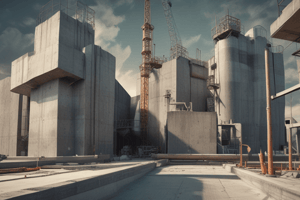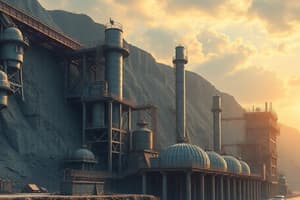Podcast
Questions and Answers
Match the following materials with their descriptions:
Match the following materials with their descriptions:
Silica Fume = A by-product from electric arc furnaces during silicon production Fly Ash = Another common pozzolan used in concrete Superplasticizers = Additives that increase workability of concrete Portland Cement = Common type of cement used in concrete mixes
Match the following characteristics with the materials:
Match the following characteristics with the materials:
Silica Fume = Particles 100 times smaller than average cement particles Fly Ash = A type of pozzolan with cementing qualities Superplasticizers = Reduces the workability issue caused by silica fume Calcium Hydroxide = Reacts with siliceous materials to form cementious compounds
Match the following terms with their definitions:
Match the following terms with their definitions:
Pozzolan = Siliceous material with no cementing quality alone Water-Cement Ratio = Affects the strength of the concrete mix Heat of Hydration = Generated due to increased surface area of silica fume Density Increase = Result of adding silica fume to concrete
Match the following impacts with their causes in concrete mixes:
Match the following impacts with their causes in concrete mixes:
Match the types of silica fume usage with their purpose:
Match the types of silica fume usage with their purpose:
Match the following components with their roles in concrete:
Match the following components with their roles in concrete:
Match the following benefits of silica fume with their reasons:
Match the following benefits of silica fume with their reasons:
Match the characteristics of silica fume with their outcomes:
Match the characteristics of silica fume with their outcomes:
Match the inventors with their significant contributions to concrete:
Match the inventors with their significant contributions to concrete:
Match the year with the significant event in concrete history:
Match the year with the significant event in concrete history:
Match the materials used to create cement:
Match the materials used to create cement:
Match the structures with their builders:
Match the structures with their builders:
Match the concepts with their descriptions:
Match the concepts with their descriptions:
Match the location with the relevant historical context:
Match the location with the relevant historical context:
Match the inventors with their patents:
Match the inventors with their patents:
Match the event with its significance in concrete development:
Match the event with its significance in concrete development:
Match the following building materials with their primary characteristics:
Match the following building materials with their primary characteristics:
Match the following historical events with their descriptions:
Match the following historical events with their descriptions:
Match the following authors with their works:
Match the following authors with their works:
Match the following engineering concepts with their purposes:
Match the following engineering concepts with their purposes:
Match the following locations with their significance in civil engineering:
Match the following locations with their significance in civil engineering:
Match the following features of reinforced concrete and structural steel:
Match the following features of reinforced concrete and structural steel:
Match the following construction techniques with their effects:
Match the following construction techniques with their effects:
Match the following publications to their topics:
Match the following publications to their topics:
Match the following types of glass fibers with their characteristics:
Match the following types of glass fibers with their characteristics:
Match the following factors with their influence on concrete toughness:
Match the following factors with their influence on concrete toughness:
Match the following measurements with their respective units:
Match the following measurements with their respective units:
Match the following statements with their implications:
Match the following statements with their implications:
Match the following applications of fiber-reinforced concrete:
Match the following applications of fiber-reinforced concrete:
Match the following effects of fibers in concrete:
Match the following effects of fibers in concrete:
Match the following lengths of fiber with their ranges:
Match the following lengths of fiber with their ranges:
Match the following properties of fiber-reinforced concrete:
Match the following properties of fiber-reinforced concrete:
Match the specifications with their corresponding characteristics:
Match the specifications with their corresponding characteristics:
Match the yield strength with its corresponding strain requirement:
Match the yield strength with its corresponding strain requirement:
Match the type of steel bar with its primary characteristic:
Match the type of steel bar with its primary characteristic:
Match the specifications with their marking requirements:
Match the specifications with their marking requirements:
Match the yield strength with its description:
Match the yield strength with its description:
Match the consideration with its importance in steel bars:
Match the consideration with its importance in steel bars:
Match the specifications with their general uses:
Match the specifications with their general uses:
Match the reinforcement characteristics with their yield strengths:
Match the reinforcement characteristics with their yield strengths:
Flashcards are hidden until you start studying
Study Notes
Cement and Concrete Development
- Early cement production involved mixing clay and limestone, burning them, and grinding the clinker for fine powder.
- Initial use of cement was primarily in stuccos, with adoption in the building industry occurring slowly.
- Portland cement was introduced in the United States in 1868, with local manufacturing beginning in the 1870s.
Pioneers of Concrete
- Key figures in early concrete development include François Le Brun, Joseph Lambot, and Joseph Monier.
- Le Brun constructed a concrete house, school, and church in 1832.
- Lambot created a concrete boat around 1850, introducing wire reinforcement.
- Monier patented reinforced concrete in 1867, focusing on combining lightness with strength.
- From 1867 to 1881, Monier patented various reinforced concrete applications, including railroad ties and arches.
Innovations and Applications
- François Coignet contributed by building reinforced concrete structures and publishing design methods in 1861.
- Use of cold-twisted bars improved bonding in concrete due to enhanced surface interaction.
- The Leland Stanford Jr. Museum in San Francisco was one of the first reinforced concrete buildings, built in 1890, demonstrating resilience during the 1906 earthquake.
Silica Fume in Concrete
- Silica fume is a by-product from electric arc furnaces, available in powder and liquid forms, enhancing concrete properties.
- When added to concrete, silica fume improves density and strength, but reduces workability, necessitating superplasticizers.
- Silica fume particles are extremely fine and reactive with calcium hydroxide, leading to cementitious compounds.
Fiber-Reinforced Concrete
- Alkali-resistant glass fibers enhance bonding with cement paste; fibers vary in length and diameter for optimal performance.
- Fibers improve concrete toughness by resisting crack propagation through the energy absorbed during breakage.
- Aspect ratio of fibers (length to diameter) and their texture significantly affect performance.
- Fiber-reinforced concrete has been used for highway pavements and airport runways, despite increased costs, due to potential long-term savings.
Steel Reinforcing Bars
- U.S. reinforcing bars primarily conform to A615 specifications; they are often made from melted reclaimed steel.
- A small number of manufacturers produce rail steel bars, with a focus on A615 for general use and A706 for welding and bending applications.
- The most common yield strengths used in reinforced concrete are 60 ksi, with an upper design limit of 80 ksi established by ACI guidelines.
Studying That Suits You
Use AI to generate personalized quizzes and flashcards to suit your learning preferences.




